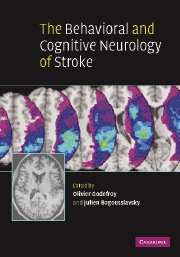Book contents
- Frontmatter
- Contents
- Contributors
- Preface
- 1 Evaluation of cognitive and behavioral disorders in the stroke unit
- Motor and gestural disorders
- Aphasia and arthric disorders
- 4 Aphasia in stroke
- 5 Acute vascular aphasia
- 6 Dysarthria
- 7 Alexia and agraphia in acute and chronic stroke
- 8 Acalculia and Gerstmann's syndrome
- Hemineglect, Anton–Babinski and right hemisphere syndromes
- Agnosia and Bálint's syndrome
- Executive and memory disorders
- Behavioral and mood disorders
- Dementia and anatomical left/right syndromes
- Index
- References
6 - Dysarthria
Published online by Cambridge University Press: 10 October 2009
- Frontmatter
- Contents
- Contributors
- Preface
- 1 Evaluation of cognitive and behavioral disorders in the stroke unit
- Motor and gestural disorders
- Aphasia and arthric disorders
- 4 Aphasia in stroke
- 5 Acute vascular aphasia
- 6 Dysarthria
- 7 Alexia and agraphia in acute and chronic stroke
- 8 Acalculia and Gerstmann's syndrome
- Hemineglect, Anton–Babinski and right hemisphere syndromes
- Agnosia and Bálint's syndrome
- Executive and memory disorders
- Behavioral and mood disorders
- Dementia and anatomical left/right syndromes
- Index
- References
Summary
Introduction
Speech motor disorders are one of the most common forms of movement disorder and are typical symptoms of numerous neurological diseases. They can be broadly categorized as apraxia of speech and dysarthria. Dysarthria has been defined as “a collective name for a group of speech disorders resulting from disturbances in muscular control over the speech mechanism due to damage of the central or peripheral nervous system. It designates problems in oral communication due to paralysis, weakness, or poor coordination of the speech musculature” (Darley et al., 1969a; 1969b; 1975). The disorder is due to abnormal neuromuscular execution and may affect the strength, speed, range, timing, and accuracy of speech movements. It can involve respiration, phonation, articulation, and prosody, either singly or in combination.
Dysarthria is a classical symptom of stroke observed in up to 30% of cases (Kumral et al., 1998; 1999; 2002; Bogousslavsky et al., 1988). It is included as a sign in the National Institutes of Health Stroke Scale (NIHSS) (Lyden et al., 1999). Melo et al. (1992) observed dysarthria in 29% of patients with isolated hemiparesis. It was also estimated to occur in about one-quarter of patients with lacunar infarction (Arboix et al., 1990). In some cases, dysarthria may be the sole sign of stroke (Fisher, 1982; Ichikawa and Kageyama, 1991; Kim, 1994).
Some studies suggest that the presence of dysarthria can have negative influences on the outcome of the stroke (Tilling et al., 2001).
- Type
- Chapter
- Information
- The Behavioral and Cognitive Neurology of Stroke , pp. 86 - 101Publisher: Cambridge University PressPrint publication year: 2007

